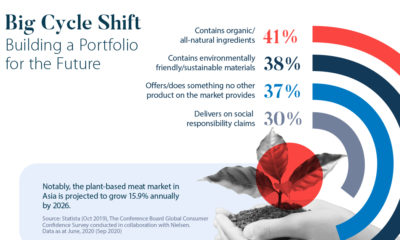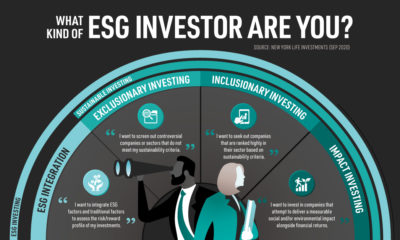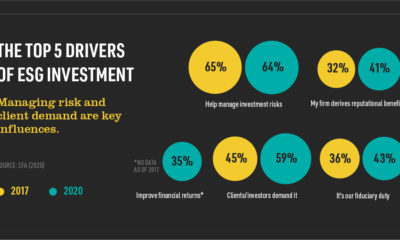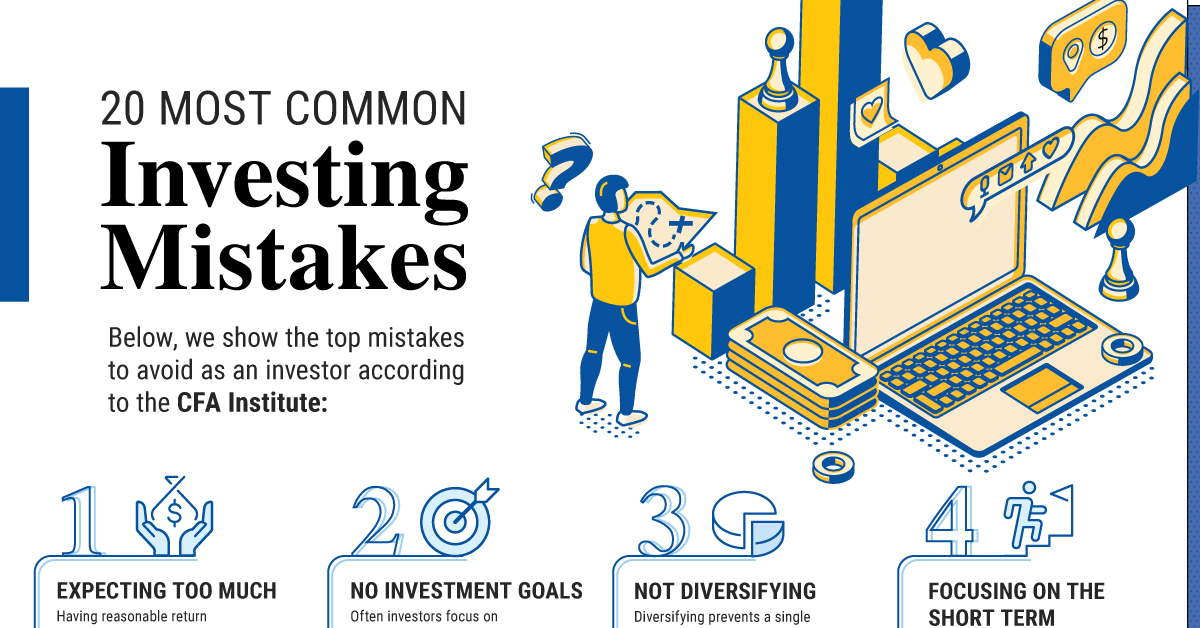This infographic is available as a poster.
Visualized: The Economic Benefits of a Green Recovery
After years of technological advancement, many renewable energy sources are now more efficient than traditional sources of energy.
Thanks to their falling prices and scalability, a green recovery, which centers on worldwide funding and policy support for green energy alternatives, is gaining strong momentum.
This infographic from New York Life Investments unpacks how a green recovery will benefit both the economy and investor portfolios.
What is a Green Recovery?
A green recovery is the intention of allocating the unprecedented global wave of public spending, pent up over the course of the 2020 pandemic, exclusively towards investment in sustainable systems to support:
- The creation of millions of jobs
- Improved productivity
- A structural decline in greenhouse gas emissions (GHG)
Green Recovery: The Economic Benefits
It is projected that nine million jobs per year will be created or saved over the next three years in a green recovery, along with 1.1% added in global economic growth annually.
Let’s look at two reasons why a sustainable recovery is gaining traction:
- Lower costs in energy spending
- More jobs created
To start, a sustainable recovery would involve 2% of U.S. GDP invested in low carbon energy. Compare this to current U.S. energy spending, which stands at roughly 6% of GDP—sitting at near lows. In fact, in the past, energy spending in the U.S. has reached as high as 13% of GDP.
Secondly, for every $1 million investment in renewable energy, more than twice as many jobs are created per category than in traditional energy. For instance, 7.5 jobs are created in the wind energy industry versus 2.2 in oil & gas.
| Per $1 Million Investment | Type | Jobs Created |
| Renewable Energy | Energy Efficiency | 7.7 |
| Wind | 7.5 |
| Solar | 7.2 |
| Traditional Energy | Coal | 3.1 |
| Oil & Gas | 2.2 |
Source: World Resources Institute, 07/28/20
With this in mind, let’s take a look at how investors can take advantage of a sustainable recovery across three industries.
1. Renewable Energy
Historically, energy demand has sharply rebounded after major economic shocks.
Following the Spanish Flu, energy demand plummeted over 15%—but rebounded by almost 25% the year after. Similarly, in the years that followed the Great Depression, World War II and the Global Financial Crisis, energy demand spiked.
In 2020, energy demand growth hit a 70-year low, created by the largest absolute decline ever. If history repeats itself, energy may be poised for a substantial demand increase.
On top of this, renewables have become significantly cheaper and scalable in recent years. Solar energy is a prime example. It is now one of the most affordable sources of electricity. In fact, the price of energy from new power plants—vital sources that generate energy for society—has changed significantly over the last decade.
| Energy Type | Price per MWh (2009) | Price per MWh (2019) | Price % Change |
| Coal | $111 | $109 | -2% |
| Solar Photovoltaic | $359 | $40 | -89% |
| Onshore Wind | $135 | $41 | -70% |
| Gas (combined cycle) | $83 | $56 | -32% |
Source: Lazard Levelized Cost of Energy Analysis via Our World in Data, 01/12/20
In 2019, over 50% of new global power capacity came from solar photovoltaic and wind power.
2. Transportation
Globally, as electric vehicle (EV) sales have accelerated, so have public chargers, illustrating a new infrastructure opportunity for investors. In 2019, there were 1 million public chargers built worldwide. Since 2014, public chargers in Europe specifically have more than doubled to over 200,000.
| Year | # of Global Electric Vehicles |
| 2012 | 110,000 |
| 2013 | 220,000 |
| 2014 | 400,000 |
| 2015 | 720,000 |
| 2016 | 1.2M |
| 2017 | 1.9M |
| 2018 | 3.3M |
| 2019 | 4.8M |
At the same time, economies are planning for a wave of green transport investments.
Italy, for instance, plans to invest $33 billion in sustainable mobility as part of its $231 billion green recovery plan. Meanwhile, Germany is investing $6 billion in the electrification and modernization of its rail and bus system. Interestingly, high-speed rail uses 12 times less energy per passenger than airplanes or road transport trips under 500 miles.
Like renewable energy, electric vehicles, high-speed rail, and modern transport infrastructure are all central to the new chapter in sustainable investment.
3. Low-carbon Technology
Finally, you can’t talk about a sustainable recovery without net-zero emissions, where all emissions created are also removed from the atmosphere.
In recent months, net-zero targets have increased substantially. In January 2020, 34% of all global emissions were covered by net-zero targets. By March 2021, this reached 50%. Decarbonization will play a critical role in reaching net-zero targets.
Crucially, net-zero emissions can be achieved through the following decarbonization options:
- Carbon capture: Chemical absorption and the injection of CO2 into depleted reserves
- Nuclear energy: Produces energy through nuclear reactions
- Storage & utilization: Improved electricity grid storage
- Renewable innovation, and others: Includes hydrogen, batteries, and scaling renewables
Even in the wake of the pandemic, global investment in decarbonization topped half a trillion dollars in 2020, 9% higher than in 2019.
New Turning Point
COVID-19 is radically reshaping the sustainable investment landscape.
In 2020, nearly 25% of all U.S. stock and bond mutual fund net inflows went into sustainable funds. By 2025, as many as half of all investments are projected to be ESG-mandated in the United States. From modern infrastructure to low-carbon tech, sustainable investments present many opportunities for investors.
Supported by lower costs and government policies, sustainable investments show potential for promising growth.


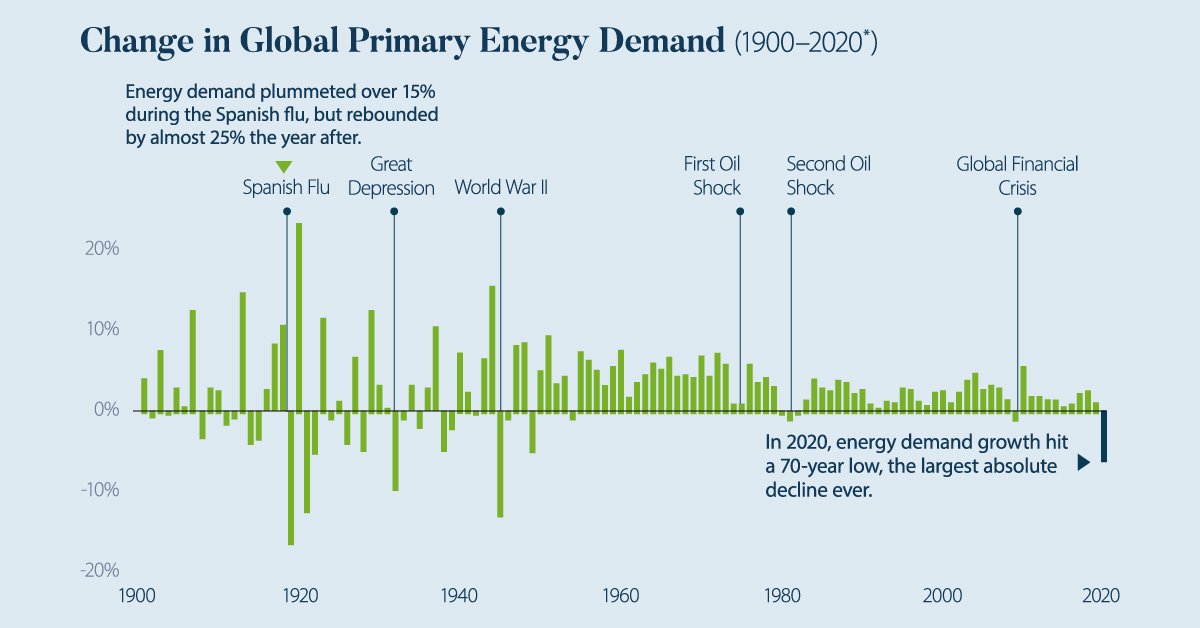

 Infographics2 years ago
Infographics2 years ago
 Markets in a Minute2 years ago
Markets in a Minute2 years ago
 Markets in a Minute2 years ago
Markets in a Minute2 years ago
 Infographics2 years ago
Infographics2 years ago
 Markets in a Minute1 year ago
Markets in a Minute1 year ago
 Markets in a Minute2 years ago
Markets in a Minute2 years ago
 Infographics1 year ago
Infographics1 year ago
 Markets in a Minute2 years ago
Markets in a Minute2 years ago







